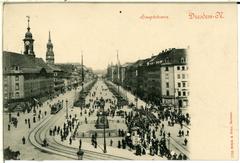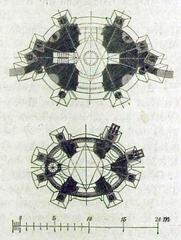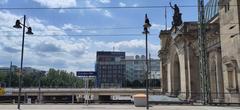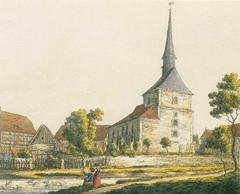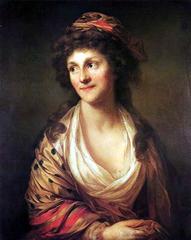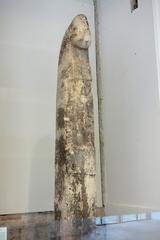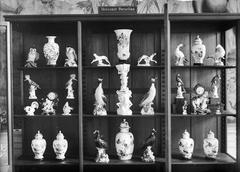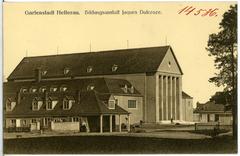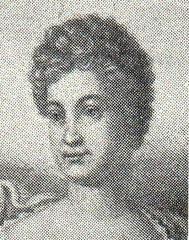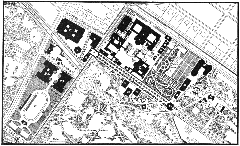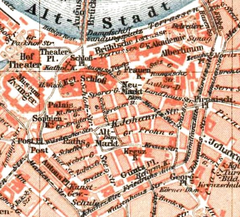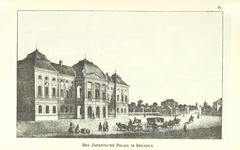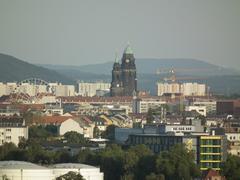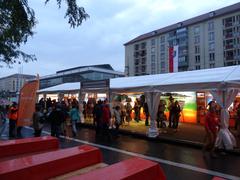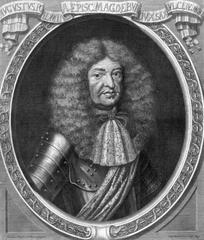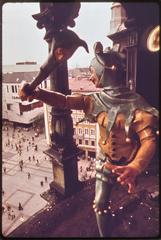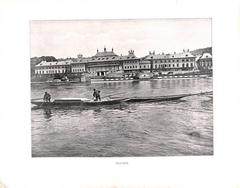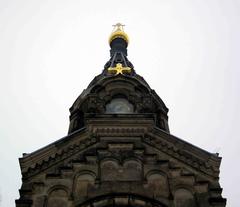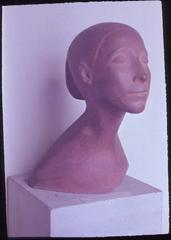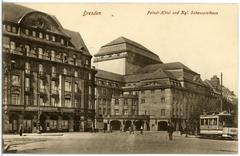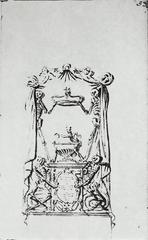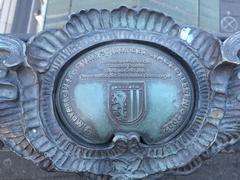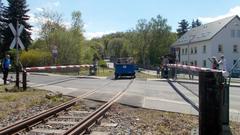Johannstadt-Süd Dresden, Germany: Visiting Hours, Tickets, and Historical Sites Guide
Date: 04/07/2025
Introduction: Discovering Johannstadt-Süd’s Unique Character
Johannstadt-Süd is a dynamic district of Dresden, Germany, blending centuries of history with scientific innovation, vibrant multicultural life, and urban renewal. Positioned along the Elbe River, Johannstadt-Süd has transformed from medieval meadows and villages to a modern community marked by both the devastation of World War II and the resilience of post-war reconstruction. Today, the district is celebrated for its historic landmarks—like the enduring Trinitatiskirche, the architectural Albertbrücke bridge, and its lively community centers, festivals, and green spaces. Whether you are passionate about history, culture, science, or urban exploration, Johannstadt-Süd offers a rich, multifaceted experience. This guide provides detailed information on visiting hours, ticketing, accessibility, attractions, and practical travel tips, ensuring you make the most of your visit. For more, see Johannstadt.de, consult the Dresden City Guide, and visit cultural venue websites.
Contents
- Overview and Historical Significance
- Visiting Johannstadt-Süd: Hours, Tickets, and Accessibility
- Top Attractions and Landmarks
- Guided Tours and Walking Routes
- Travel Tips
- Artistic and Cultural Venues
- Festivals, Events, and Local Traditions
- Multiculturalism and Community Engagement
- Architectural and Urban Identity
- Green Spaces and Urban Livability
- Markets and Local Gastronomy
- Annual Events and Festivals
- Practical Visitor Tips
- Unique Local Experiences
- Frequently Asked Questions (FAQ)
- Visuals and Media Suggestions
- Resources and Official Links
Overview and Historical Significance
Johannstadt-Süd tells the story of Dresden’s resilience and cultural evolution. Originating as riverside settlements, the area was heavily bombed in 1945, leaving vast ruins. Post-war, the district was rebuilt with a mix of socialist-era “Plattenbau” apartment blocks, preserved historical buildings, and new scientific institutions. Today, Johannstadt-Süd is a lively, inclusive community, known for its diversity, public art, and urban renewal projects. Its streets, festivals, and green spaces offer a window into Dresden’s layered history and vibrant present.
Visiting Johannstadt-Süd: Hours, Tickets, and Accessibility
General Access:
Johannstadt-Süd is an open, walkable district with no entry fee or restricted visiting hours. Public areas, parks, and landmarks can be explored year-round at your own pace.
Cultural Venues:
Community centers like Johannstädter Kulturtreff and JoJo Kindertreff typically operate weekdays, 10:00 AM–6:00 PM, with some weekend events. Most workshops and festivals are free or low-cost; some special events (e.g., Saalfasching carnival) require advance ticket purchase (Johannstadt.de).
Accessibility:
The district is well-served by tram (lines 3, 6, 7, 10, 12) and bus, with major stops at Fetscherplatz and Bönischplatz. Wheelchair access is available in public spaces and most venues; contact sites in advance for details.
Best Time to Visit:
April to October offers the best weather for exploring green courtyards, riverside paths, and outdoor events.
Top Attractions and Landmarks
- Albertbrücke Bridge: Iconic link between Johannstadt and Dresden’s Neustadt, ideal for riverside walks and photography.
- Jägerkaserne: 19th-century barracks representing Saxony’s military and architectural heritage.
- Trinitatiskirche (Trinity Church): Survived WWII bombings as a ruin, restored as Dresden’s Jugendkirche (Youth Church), and now hosts worship, concerts, and cultural events.
- Visiting: Tuesday–Sunday, 10:00 AM–6:00 PM, free entry, donations welcome, wheelchair accessible (jugendkirche-dresden.de).
- Großer Garten: Dresden’s largest urban park, just a short walk away, perfect for relaxation and recreation.
- Max Planck Institute & BioInnovationszentrum: Centers for scientific research (external viewing only).
Guided Tours and Walking Routes
Local organizations offer guided walking tours, highlighting Johannstadt-Süd’s transformation from a medieval village to a scientific and cultural hub. Maps and downloadable guides are available (Johannstadt.de).
Travel Tips
- Use tram lines 6 or 12 for direct access from Dresden’s city center.
- Wear comfortable shoes to explore the district’s boulevards and riverside paths.
- Plan your visit during the Johannstädter Festspiele for vibrant local festivities.
- Find amenities such as cafes, restaurants, and shops at Modrow-Kaufhalle and on Neubertstraße.
Artistic and Cultural Venues
- Johannstädter Kulturtreff: Community center offering workshops, exhibitions, and concerts; open Monday–Friday, 9:00 AM–8:00 PM (kulturtreff-johannstadt.de).
- JoJo Kindertreff: Creative hub for children and families, with mobile and stationary meeting points for ages 6–14.
- Public Art: Murals, sculptures, and installations adorn courtyards and buildings, reflecting local creativity and history (Secret Attractions).
Festivals, Events, and Local Traditions
- Johannstädter Festspiele: Annual festival with music, performances, and local food along the Elbe.
- Saalfasching Carnival: Winter celebration with themed parties and live music (tickets required).
- Open-air concerts and markets: Hosted throughout the year by JohannStadt Quartier e. V.
Multiculturalism and Community Engagement
Johannstadt-Süd is home to a diverse population, fostering a rich culinary scene, intercultural festivals, and language courses. Projects like BIBLIOTOP combine ecological, creative, and library services, while community gardening and cooking events promote social cohesion (Johannstadt.de).
Architectural and Urban Identity
Post-war reconstruction gave rise to distinctive “Plattenbau” housing blocks, integrated with historic buildings and modern developments. The district’s architecture symbolizes both destruction and renewal, with ongoing citizen-led urban improvements.
Green Spaces and Urban Livability
Parks, gardens, and green courtyards abound, supporting outdoor events, sports, and relaxation. Highlights include the Elbestrand (Elbe beach), Elbwiesen (Elbe meadows), and the inclusive, modern Lili-Elbe-Straße, featuring water play areas and playgrounds.
Markets and Local Gastronomy
- Dresden’s Largest Flea Market: Saturdays under Käthe-Kollwitz-Ufer, offering antiques and handmade goods.
- Pizzeria Fantina: Authentic Sicilian pizza on Neubertstraße.
- Café Kardamom: Renowned for tea and baklava on Pfotenhauerstraße.
- Johann Restaurant & Elblounge: Sustainable fine dining in a historic riverside building.
Annual Events and Festivals
- Bönischplatzfest: Community festival with music and performances each spring.
- Johannstädter Elbeschwimmen: Summer tradition inviting swimmers across the Elbe.
- Drachenfest & Johannstädter Advent: Autumn kite festival and December “living calendar” of free events.
Practical Visitor Tips
- Transport: Trams and buses from city center stops at Fetscherplatz and Bönischplatz.
- Cycling: The Elberadweg (Elbe Cycle Path) offers scenic routes.
- Safety: Generally safe; standard urban precautions during crowded events.
- Sustainability: Community gardens and recycling programs are supported by active local initiatives.
Unique Local Experiences
- Fährgarten: Riverside beer garden with Elbe views and ferry crossings.
- Art in Public Spaces: GDR-era murals and sculptures in residential complexes.
- Hidden Gems: Peaceful cemeteries and the story-rich Lili-Elbe-Straße.
Frequently Asked Questions (FAQ)
Q: Are there entrance fees for major attractions?
A: Most outdoor sites and Trinitatiskirche are free. Some events and venues may charge tickets.
Q: Best months to visit?
A: April–October for outdoor activities and festivals.
Q: Is the district wheelchair accessible?
A: Most public spaces and venues like Trinitatiskirche are accessible; check individual sites for details.
Q: Are guided tours available?
A: Yes, through local organizations and by appointment at main landmarks.
Q: Where can I find official visitor information?
A: dresden.de, johannstadt.de, and specific venue websites.
Visuals and Media Suggestions
- Use images of Johannstädter Kulturtreff, Trinitatiskirche, and Elbestrand with detailed alt text (e.g., “Trinitatiskirche Johannstadt-Süd exterior”).
- Interactive maps and virtual tours are available on Dresden’s tourism portals.
Resources and Official Links
Summary and Recommendations
Johannstadt-Süd is a testament to Dresden’s resilience, creativity, and communal spirit. From historic sites like Trinitatiskirche and the Johannstadt Memorial to lively festivals, markets, and public art, the district offers a rich, inclusive experience. Excellent public transport, accessible venues, and abundant green spaces ensure a welcoming environment for all visitors. To enhance your visit, download the Audiala app for guided tours and event updates, and consult official resources for the latest information. Whether you’re a history lover, family traveler, or culture enthusiast, Johannstadt-Süd invites you to discover its many stories and vibrant community.
References
- Johannstadt-Süd: A Visitor’s Guide to Dresden’s Historic and Vibrant District, 2025 (https://www.johannstadt.de/orte/geschichte-der-johannstadt/)
- Exploring Johannstadt-Süd: Visiting Hours, Tickets, and Cultural Highlights in Dresden, 2025 (https://www.johannstadt.de/2025/02/winterferien-tipps-2025-angebote-in-johannstadt/)
- Johannstadt-Süd Attractions: Visiting Hours, Tickets & Dresden Historical Sites Guide, 2025 (https://jugendkirche-dresden.de), (https://johannstadthalle.de), (https://www.dresden.de/en/tourism/)
- Visiting the Johannstadt Memorial in Dresden: Hours, Tickets, and Travel Tips, 2025 (https://www.dresden.de/en/tourism/)


